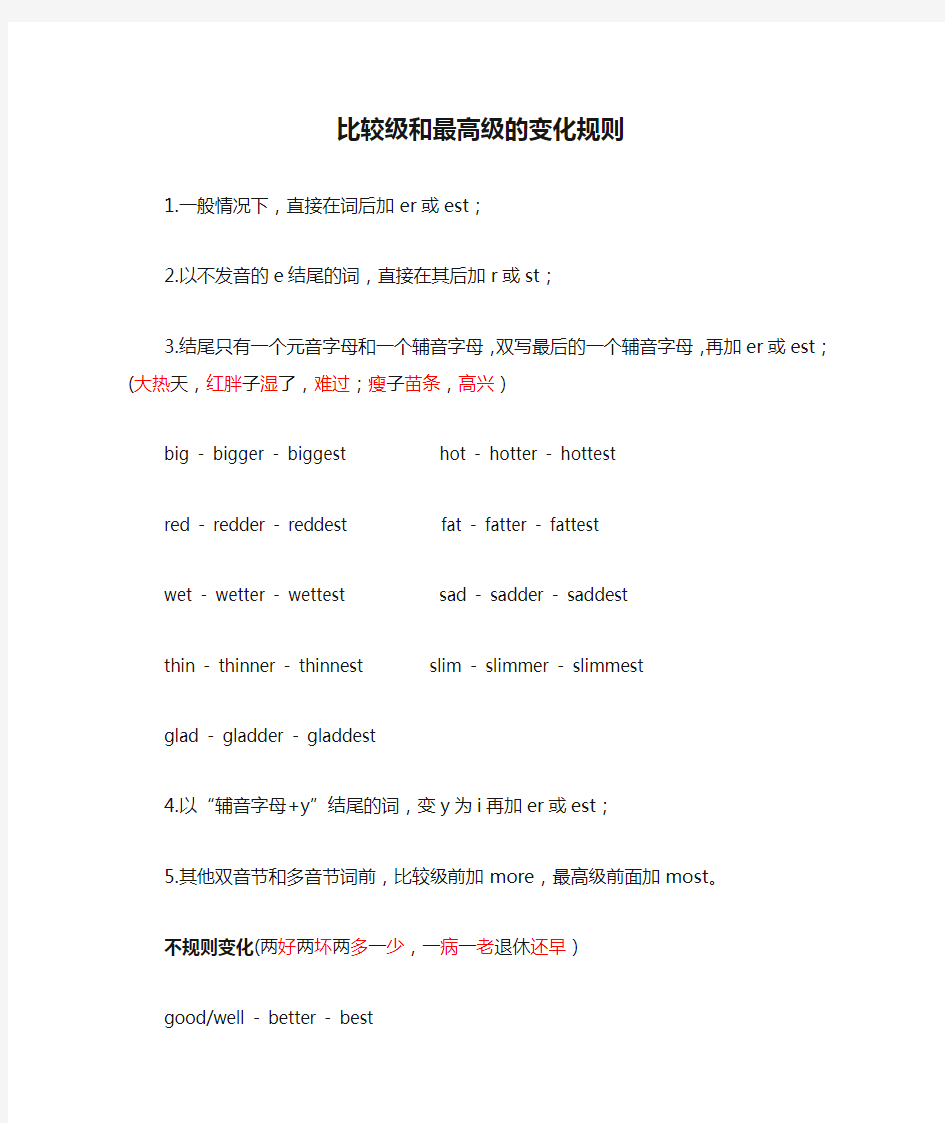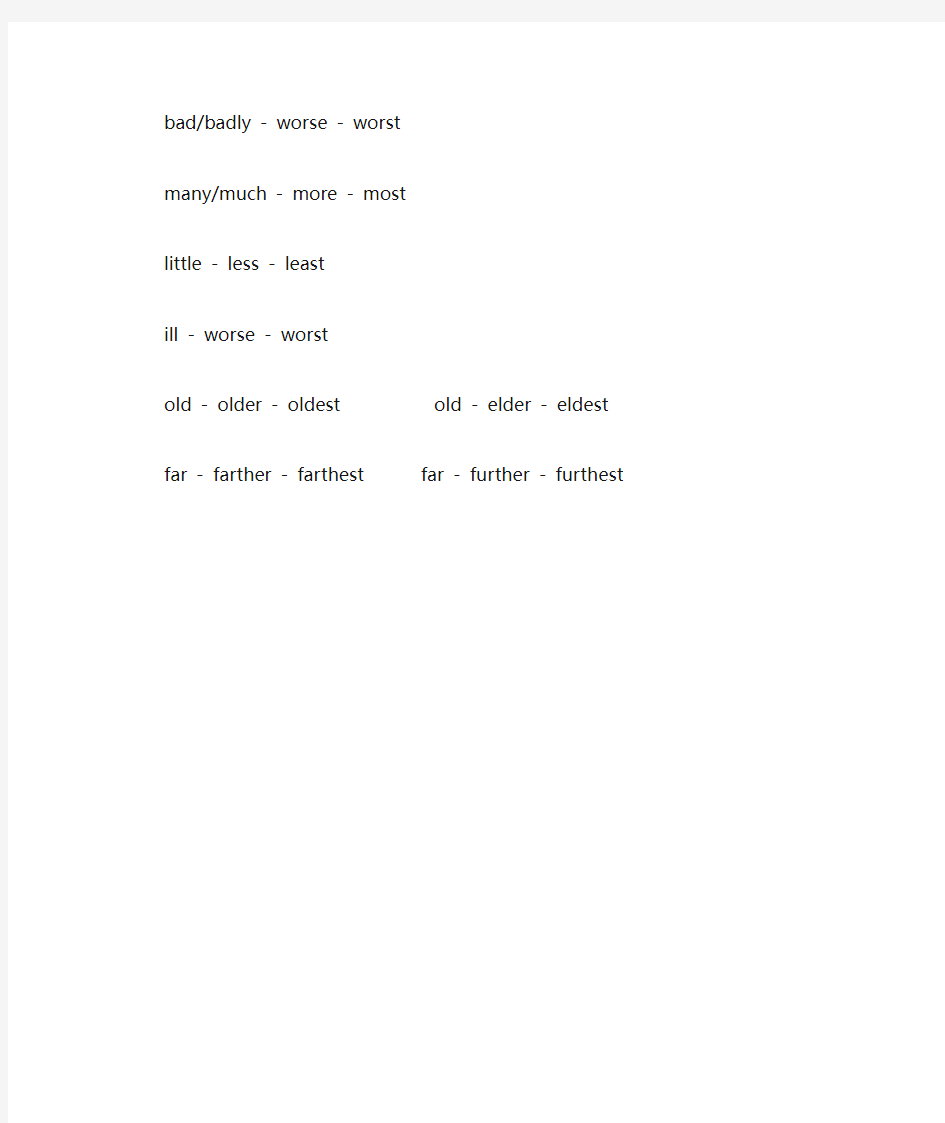

比较级和最高级的变化规则
1.一般情况下,直接在词后加er或est;
2.以不发音的e结尾的词,直接在其后加r或st;
3.结尾只有一个元音字母和一个辅音字母,双写最后的一个辅音字母,再加er或est;(大热天,红胖子湿了,难过;瘦子苗条,高兴)big - bigger - biggest hot - hotter - hottest
red - redder - reddest fat - fatter - fattest wet - wetter - wettest sad - sadder - saddest thin - thinner - thinnest slim - slimmer - slimmest glad - gladder - gladdest
4.以“辅音字母+y”结尾的词,变y为i再加er或est;
5.其他双音节和多音节词前,比较级前加more,最高级前面加most。
不规则变化(两好两坏两多一少,一病一老退休还早)
good/well - better - best
bad/badly - worse - worst
many/much - more - most
little - less - least
ill - worse - worst
old - older - oldest old - elder - eldest
far - farther - farthest far - further - furthest
英语语法---比较级和最高级的用法 在英语中通常用下列方式表示的词: 在形容词或副词前加more(如more natural,more clearly )或加后缀-er(newer,sooner )。 典型的是指形容词或副词所表示的质、量或关系的增加。英语句子中,将比较两个主体的方法叫做“比较句型”。其中,像“A比B更……”的表达方式称为比较级;而“A最……”的表达方式则称为最高级。组成句子的方式是将形容词或副词变化成比较级或最高级的形态。 一、形容词、副词的比较级和最高级的构成规则 1.一般单音节词和少数以-er,-ow结尾的双音节词,比较级在后面加-er,最高级在后面加-est; (1)单音节词 如:small→smaller→smallest short→shorter→shortest tall→taller→tallest great→greater→greatest (2)双音节词 如:clever→cleverer→cleverest narrow→narrower→narrowest 2.以不发音e结尾的单音节词,比较在原级后加-r,最高级在原级后加-st; 如:large→larger→largest nice→nicer→nicest able→abler→ablest 3.在重读闭音节(即:辅音+元音+辅音)中,先双写末尾的辅音字母,比较级加-er,最高级加-est; 如:big→bigger→biggest hot→hotter→hottest fat→fatter→fattest 4.以“辅音字母+y”结尾的双音节词,把y改为i,比较级加-er,最高级加-est; 如:easy→easier→easiest heavy→heavier→heaviest busy→busier→busiest happy→happier→happiest 5.其他双音节词和多音节词,比较级在前面加more,最高级在前面加most; 如:beautiful→more beautiful→most beautiful different→more different→most different easily→more easily→most easily 注意:(1)形容词最高级前通常必须用定冠词the,副词最高级前可不用。 例句:The Sahara is the biggest desert in the world. (2)形容词most前面没有the,不表示最高级的含义,只表示"非常"。 It is a most important problem.=It is a very important problem. 6.有少数形容词、副词的比较级和最高级是不规则的,必须熟记。 如:good→better→best well→better→best bad→worse→worst ill→worse→worst old→older/elder→oldest/eldest many/much→more→most little→less→least far →further/farther→ furthest/farthest 二、形容词、副词的比较级和最高级的用法 1.“A + be +形容词比较级+ than + B” 意思为“A比B更……”。 如:This tree is taller than that one. 这棵树比那棵树高。 注意: ①在含有连词than的比较级中,前后的比较对象必须是同一范畴,即同类事物之间的比较。 ②在比较级前面使用much,表示程度程度“强得多”。 如:A watermelon is much bigger than an apple. ③very, quite一般只能修饰原级,不能修饰比较级。 2.“比较级+ and + 比较级”或“more and more +原级”表示“越来越……” 如:It becomes warmer and warmer when spring comes.
比较级与最高级语法专讲 形容词分为三种等级:原级,比较级与最高级。 一、形容词的原级及用法 ◆形容词的原级(形容词本来面目不作变化) 1.表示没有进行比较或进行同级比较 2.可以修饰原级的词: very , quite , enough(“足够”,用在形容词后) , so , pretty , too , how , rather(相当) . (not) as/so…as (不)像/如…一样, 同级比较= less + adj ./adv .原形+than e.g. 我们多么高兴啊!How happy we are ! 这把尺子和那把一样长。 This ruler is as long as that one . (变否定句) 这把尺子不如那把长 This ruler isn’t as/so long as that one . This ruler is less long than that one . 二、形容词比较级最高级变化规则 ①单音节词比较级在词尾加er,最高级加est cold —colder —coldest tall —taller —tallest high —higher —highest long —longer —longest ②以字母e结尾的词只加r或st nice —nicer —nicest late —later —latest fine —finer —finest ③重读闭音节双写辅音字母再加er或est big —bigger —biggest hot —hotter —hottest wet —wetter —wettest thin —thinner —thinnest red—redder —reddest fat —fatter —fattest sad —sadder —saddest ④以辅音字母+y结尾的词把y变i再加er或est easy — easier — easiest early — earlier — earliest funny — funnier — funniest happy — happier — happiest heavy— heavier — heaviest dirty — dirtier — dirtiest ⑤多音节词、部分双音节词(特别是ful结尾及v.+ed/ing构成的形容词)及个别单音节词(fun)在前面加more或most interesting important difficult excited tired careful popular expensive boring fun ⑥不规则变化 little —— less —— least good / well —— better —— best bad / ill / badly —— worse —— worst many / much —— more —— most old —— older —— oldest (年龄大的,与than连用) old —— elder ——eldest(“年长的”,只作定语不与than连用) far —— farther —— farthest (距离远) far —— further —— furthest (除距离外,还指程度上更进一步的) ◆副词比较级和最高级的变化规则大致与此相同 三、比较级用法 1.表示两者之间进行比较,“更…” 2.可以修饰比较级的词: much = a lot (…得多) a little = a bit (…一点点) even (甚至) far (远远…) any (丝毫,稍微,) 用于否定和疑问句中 3.比较级标志: than or 4.形容词比较级句式:①A +谓语动词+ 形容词的比较级+ than + B. (A比B…) 玛丽比凯特更瘦。Mary is thinner than Kate. ②Which/Who +谓语动词+形容词比较级, A or B? (哪个/谁更…, A 还是B?) Who runs faster , Mary or Kate ? 6.比较级特殊用法: ①the +比较级+of the two… ——“两者中较…的” 他是两个男孩中较高的。He’s the taller one of the two boys . ②“比较级+and+比较级”或“more and more +多音节词” ——“越来越…” 他越来越高。He’s taller and taller 英语越来越重要English is more and more important . ③The+比较级…, the+比较级… “越…, 越…” 你越快乐就越美丽。The happier you are , the more beautiful you are . ④the +序数词+形容词最高级+n 意为第几最……的 The Yellow river is the second longest river in China. 黄河是中国第二长的河流。 ⑤比较级+than any other +n单.+in+同一范围 她比班里其他任何一个女孩都漂亮。She’s more beautiful than any other girl in our class. = 她是班上最漂亮的女孩。She’s the most beautiful girl in our class. ◆该用法虽然出现了in所引导的比较范围但是仍要用比较级,此成为用比较级表示最高级,实质是最高级。 四、最高级用法 1.表示三者或三者以上的比较,“最…” 2.比较级前必须加the , 副词前的the可以省略。 3.最高级标志:in of or(三者及三者以上) in后跟比较范围, of后跟进行比较的同类事物。 4.句式: ①the +最高级+(n.) + in +比较范围 我是我们班最聪明的。I’m the smartest in our class. ②the + 最高级+(n.) + of +同类事物 这本书是所有书中最有趣的。This book is the most interesting of all the books. ③Which/Who +v.(单数) +最高级, A, B or C? Jay, Will和Jack谁最收欢迎?Who is the most popular, Jay, Will or Jack? 五、例题解析与难点攻克 ◆主语为物时的比较对象的一致性问题 1. My bag is bigger than you. 误 My bag is bigger than your. 误 My bag is bigger than your bag. 正 My bag is bigger than yours. 正 比较对象应与主语对等,than后的其比较对象可为: ①限定词+n. ②名词所有格(一般省略其后相同的名词) ③名词性物主代词(=形容词性物主代词+n.) mine,yours ,his,hers ,its ,ours,theirs 4. The weather in Beijing is colder than that in Shanghai. 当主语有后置定语修饰时,为保证比较对象一致,常用that/those指代比较对象。
比较级和最高级 1.用“as+原级+as”表示 Tom is as tall as Mike. 2.用“not as(so) +原级+as”或“less than”表示 I didn’t do my homework so(as) carefully as you. The picture is less attractive than that one. 3.用“比较级+than”表示 Our city is more beautiful than any other city in our country. 注意:1) 为了避免重复,在从句中常用one, that, those等词来代替前面提过的名词。 The weather here is warmer than that of Shanghai. The radios made in our factory are better than those in your factory. 2)比较等级应注意避免和包括自己的对象比。 比较级+than+ any other + 单数名词 all the other + 复数名词 anyone else any of the other + 复数名词 3)如果形容词作定语修饰一个单数可数名词,一般将不定冠词a/an放在形容词之后。 Our neighbour has _____ ours. A. as a big house as
B. as big a house as C. the same big house as D. house the same big as 4)比较级前一般不用冠词,但若表示“两者中较……时”。比较级前要加定冠词。若比较级后有名词,常在比较级前加不定冠词,表示泛指。 E.g. 他是两者中较高的一个 He is the taller of the two. 她唱得真动听!我可从未听过比这更好的嗓音了。 How beautifully she sings! I have never heard a better voice. 4. 三者或三者以上相比,表示最高级时,用“the +最高级”的结构表示,这种句式一般常有表示比较范围的介词短语。 Zhang Hua is the tallest of the three. He works (the) hardest in his class. That was the least exciting football game I’ve ever watched. This hotel is the most comfortable I’ve ever stayed. 注意:当最高级的前面无限定词the或有不定冠词a/an时,仅表示“很……,非常……” Monday is my busiest day. 星期一是我很忙的一天。 Qingdao is a most (very) beautiful coastal city. 青岛是一个非常美丽的海滨城市。 一、请写出下列形容词的比较级和最高级。 big ______ ______ small ______ ________ new ____?__ ________ tall ______ ______ short______ ________ old____?__ ________ weak ______ ______ strong ______ ______ fat____?__ ________ hot ______ ______ cold ______ ________ thin ____?__ ________ nice ______ _____ good ______ ________ high____?__ ________ low____?__ ________cheap______ ______ easy ______ ________
小学六年级英语比较级和最高级的知识讲解 学习重难点: 1.熟练掌握形容词和副词比较级和最高级的构成。 学习过程及内容: 比较级:两者间的比较。最高级:三者及其以上比较,选出一个“最”。 一.了解什么是单音节,双音节和多音节。 二.掌握单音节词和部分双音节词比较级和最高级的构成、用法。 1.构成。 知识点(1).一般情况在原级词尾加-er构成比较级,加-est构成最高级。 如:Small→smaller→smallest clever→cleverer→cleverest。 例题:Short tall Cheap narrow 知识点(2).以e结尾的词,直接加-r 或-st。 如:large→larger→largest nice→nicer→nicest 注意:late→later(较晚的)→latest(最新近的)(时间的先后) late→latter(稍后的)→last(最后的)(顺序上的先后)例题:nice able safe 知识点(3).以一个辅音字母结尾,其前面的元音字母发短元音的形容词的比较级和最高级,是双写该辅音字母然后再加-er和-est。(注意:这里是字母,不是音标。辅音字母是除a,e,i,o,u五个元音字母以外的都是辅音字母。) 如:big→bigger→biggest。 例题:hot fat thin 知识点(4).以“辅音字母+ y”结尾的词,先变“y”为“i”,再加-er 或-est。 如:happy→happier→happiest easy→easier→easi est 例题:heavy
busy lucky 知识点(5)不规则变化,常见的有这六个。 good / well→better→best bad / ill→worse→worst many / much→more→most little→less→least far→farther→farthest(表示距离) / far→further→furthest (表示程度) old→older / elder→oldest (表示新旧或年龄) / eldest (表示兄弟姐妹之间的长 幼关系) 2.用法。 比较级:A +be(is/am/are) + 形容/副词比较级+ than + B 如:Yao Ming is tall than me. I’m short than Yao Ming. 例题:(1)The red box is (heavy)than the blue box. (2)I’m three yeas (older/elder)than him. (3)This man is than that man. 最高级:A+the+形容/副词最高级+表示的范围(in比较对象不是同一类,of比较对象时同类) 如:Tom is the tallest student in his class. The Yellow River is the scend longest river in Chian. 例子:(1)Apple A is the (big) of the three/ in the box. (2)用heavy,bad的比较级和最高级造句。 (3)Which subject do you like ,maths or english? A.good B.better C.well D.best 三.大部分双音节词和多音节词的构成。 大部分的双音节词和多音节词,比较级在前面加more,最高级在前面加most。 注意:(1)形容词最高级前通常必须用定冠词the,副词最高级前可不用。 (2)形容词most前面没有the,就没有最高级的意思,不表示最高级的含义,只表示"非常",用来加强语气之意。 如:beautiful→more beautiful→most beautiful different→more different→most different easily →more easily →most easily
初中英语语法比较级和最高级专项练习 口诀:一者比较用原级,比较级限二者比,三者三者往上比,最高级的用法起;若甲乙程度相同,as…as结构体;若甲某方面不及乙,not so/as…as来担起;中间形、副连接要切记! 1、--our English is very good. ——But my brother learns it much______than I do.(’97山东) A. good B.well C. better D. best 【析】在英语中,a little,a lot,much,even等词可以用来修饰形容词或副词的比较级,故本题的正确答案是C项 2.Don‘t worry. Your granny will get_______ (’98昆明) A.well and well B.better and better C.well and better D.good and well 【析】表示"越来越……"可以采用"比较级+比较级"或"more and more+原级"的结构,如果是单音节的形容词或副词,则用前一结构;如果是多音节词,则可以用后一种结构,故本题的正确答案是B 3.China is one of________ in the world.(‘98山西) A.the oldest country B.the oldest countries C.much older country D.much older countries 【析】在英语中,要表示"其中最……的之一",应使用"one of+形容词的最高级形式+名词的复数形式"根据题意,本题应选B项 4.The girl doesn’t run________ the boy.(‘98广州) A. much faster as B. as faster as C. more fast than D. so fast as 【析】在英语中,可以使用"as…as"表示"两者在某方面一样";用"not so/as……as"表示"两者在某方面不一样",以上两种结构都必须使用形容词或副词的原级由以上分析可知本题的D项最符合题意 5.LiLei writes ______ of all the students in our class. A. more carefully B. the most careful C. more careful D. most carefully
形容词的比较级和最高级知识讲解及练习 2Task1. 形容词的主要句法功能(让学生举例说明) 1.做定语,放于名词前或不定代词后。如:I have something interesting to tell you. 2.做表语,放于系动词后。如:The book is very useful. 3.做宾语补足语,放在keep, make, leave, find等动词的宾语后做宾语 补足语。如:Don’t keep the door closed. 4.以a-开头的形容词alive, asleep, afraid, alone等一般只做表语(alive 有时可做后置定语) 5.the 加上某些形容词相当于名词,表示某一类人或事物。如:The blind need help. 6.修饰表示长度、宽度和厚度等计量单位的词时,要后置。如:half a meter deep 7.下列以- ly 结尾的词是形容词而不是副词:friendly, silly, lovely,lonely,lively等。 8.多个形容词作定语时顺序,“限观形龄颜国材”。如: a small old blank wooden desk Task2.副词的主要句法功能(学生举例说明) 9.做状语,修饰形容词副词,通常放在所修饰词之前;修饰动词时, 一般放在被修饰词之后;位于句首,修饰整个句子。Luckily, he wasn’t badly hurt. 10.做定语,一般放在所修饰词之后。如:the people here, the man upstairs 11形容词变副词规则变化: ①直接加 ly ②以“辅音+y 结尾的词,变y为 i,再加-ly”③le结尾变le 为 ly Eg: possible--- possibly terrible--- terrible comfortable –comfortably simple—simply gentle---gently④本身既是形容词也是副词fast ,early , high , hard , late ,far ,wide ,alone⑤初中阶段唯一一个需要去掉字母e的单词 true --truly⑥不用去掉字母e。类似的词还有:widely, nicely, closely, rudely, bravely, extremely, politely 12enough 形容词和副词的后面13hard/hardly几乎不 Ⅰ. 常见的形容词及比较级和最高级的构成 (1)规则变化: ①单音节和部分双音节的形容词一般在词尾加-er Eg: calm---calmer tall---taller smart---smarter ②以字母e结尾的直接在词尾加-r
英语比较级和最高级的用法 一、形容词、副词的比较级和最高级的构成规则 1.一般单音节词和少数以-er,-ow结尾的双音节词,比较级在后面加-er,最高级在后面加-est; (1)单音节词 如:small→smaller→smallest short→shorter→shortest tall→taller→tallest great→greater→greatest (2)双音节词 如:clever→cleverer→cleverest narrow→narrower→narro west 2.以不发音e结尾的单音节词,比较在原级后加-r,最高级在原级后加-st; 如:large→larger→largest nice→nicer→nicest able→abler→ablest 3.在重读闭音节(即:辅音+元音+辅音)中,先双写末尾的辅音字母,比较级加-er,最高级加-est; 如:big→bigger→biggest hot→hotter→hottest fat→fatter→fattest 4.以“辅音字母+y”结尾的双音节词,把y改为i,比较级加-er,最高级加-est; 如:easy→easier→easiest heavy→heavier→heaviest busy→busier→busiest happy→happier→happiest 5.其他双音节词和多音节词,比较级在前面加more,最高级在前面加most; 如:beautiful→more beautiful→most beautiful different→more different→most different easily→more easily→most e asily 注意:(1)形容词最高级前通常必须用定冠词 the,副词最高级前可不用。 例句: The Sahara is the biggest desert in the world. (2) 形容词most前面没有the,不表示最高级的含义,只表示"非常"。 It is a most important problem. =It is a very important problem. 6.有少数形容词、副词的比较级和最高级是不规则的,必须熟记。 如:good→better→best well→better→best bad→worse→worst ill→worse→worst
英语比较级和最高级的用法归纳 在学习英语过程中,会遇到很多的语法问题,比如比较级和最高级的用法,对于 这些语法你能够掌握吗?下面是小编整理的英语比较级和最高级的用法,欢迎阅读! 英语比较级和最高级的用法 一、形容词、副词的比较级和最高级的构成规则 1.一般单音节词和少数以-er,-ow结尾的双音节词,比较级在后面加-er,最高级 在后面加-est; (1)单音节词 如:small→smaller→smallest short→shorter→shortest tall→taller→tallest great→greater→greatest (2)双音节词 如:clever→cleverer→cleverest narrow→narrower→narrowest 2.以不发音e结尾的单音节词,比较在原级后加-r,最高级在原级后加-st; 如:large→larger→largest nice→nicer→nicest able→abler→ablest 3.在重读闭音节(即:辅音+元音+辅音)中,先双写末尾的辅音字母,比较级加-er,最高级加-est; 如:big→bigger→biggest hot→hotter→hottest fat→fatter→fattest 4.以“辅音字母+y”结尾的双音节词,把y改为i,比较级加-er,最高级加-est; 如:easy→easier→easiest heavy→heavier→heaviest busy→busier→busiest happy→happier→happiest 5.其他双音节词和多音节词,比较级在前面加more,最高级在前面加most; 如:bea utiful→more beautiful→most beautiful different→more different→most different easily→more easily→most easily 注意:(1)形容词最高级前通常必须用定冠词 the,副词最高级前可不用。 例句: The Sahara is the biggest desert in the world. (2) 形容词most前面没有the,不表示最高级的含义,只表示"非常"。 It is a most important problem. =It is a very important problem.
一、比较级和最高级的讲解 1.一般单音节词和少数以-er,-ow结尾的双音节词,比较级在后面加-er,最高级在后面加-est; (1)单音节词 如:small→smaller→smallest short→shorter→shortest tall→taller→tallest great→greater→greatest (2)双音节词 如:clever→cleverer→cleverest narrow→narrower→narrowes t 2.以不发音e结尾的单音节词,比较在原级后加-r,最高级在原级后加-st;如:large→larger→largest nice→nicer→nicest able→abler→ablest 3.在重读闭音节(即:辅音+元音+辅音)中,先双写末尾的辅音字母,比较级加-er,最高级加-est; 如:big→bigger→biggest hot→hotter→hottest fat→fatter→fattest 4.以“辅音字母+y”结尾的双音节词,把y改为i,比较级加-er,最高级加-est;如:easy→easier→easiest heavy→heavier→heaviest busy→busier→busiest happy→happier→happiest 5.其他双音节词和多音节词,比较级在前面加more,最高级在前面加most;如:beautiful→more beautiful→most beautiful different→more different→most different easily→more easily→most e asily 注意:(1)形容词最高级前通常必须用定冠词the,副词最高级前可不用。例句:The Sahara is the biggest desert in the world. (2)形容词most前面没有the,不表示最高级的含义,只表示"非常"。 It is a most important problem. =It is a very important problem. 6.有少数形容词、副词的比较级和最高级是不规则的,必须熟记。 如:good→better→best well→better→best bad→worse→worst ill→worse→worst old→older/elder→oldest/eldest many/much→more→most little→less→least far →further/farther→ furthest/farthest 二、形容词、副词的比较级和最高级的用法 1.“A + be +形容词比较级+ than + B” 意思为“A比B更……”。 如:This tree is taller than that one. 这棵树比那棵树高。 注意: ①在含有连词than的比较级中,前后的比较对象必须是同一范畴,即同类事物之间的比较。 ②在比较级前面使用much,表示程度程度“强得多”。 如:A watermelon is much bigger than an apple. ③very, quite一般只能修饰原级,不能修饰比较级。 2.“比较级+ and + 比较级”或“more and more +原级”表示“越来越……”
形容词的比较级和最高级知识讲解及练习 Ⅰ. 常见的形容词及比较级和最高级的构成(规则变化): ①. 在单词末尾加________ 构成比较级;加the 和______ 构成最高级。如:small(小的)→_________ (更小的) →________ _______ (最小的) short短的long长的new新的young年轻的kind和蔼的 clean干净的 quiet宁静的 calm 镇静的 clever聪明的 smart机灵的 cold寒冷的 cool凉爽的 warm暖和的 tall高的 ②. 在单词末尾加________ 构成比较级;加the 和______ 构成最高级。 如:nice(漂亮的)→_________ (更漂亮的) →__________________ (最漂亮的) large 大的white白的fine好的late晚的 ③. 先改单词末尾的______ 为______, 加________ 构成比较级;加the 和______ 构成最高级。 如:funny(风趣的)→_________ (更风趣的) →________________ (最风趣的) scary恐怖的pretty漂亮的friend友好的ugly难看的 lazy懒惰的 shy害羞的 curly卷曲的 heavy重的 easy容易的 ④. 先双写在单词末尾的_________字母, 再加________ 构成比较级;加the 和______ 构成最高 级。如:red(红的)→________ (更红的) →________________ (最红的) red 红的big大的hot热的thin瘦的fat胖的 ⑤. 在单词前加________构成比较级;加_________ _________ 构成最高级 如:interesting(有趣的)→_____________ (更有趣的)→_________________ (最有趣的)
形容词比较级、最高级变化表 一、形容词比较级、最高级变化规则 1.在形容词词尾加上“er” “est” 构成比较级、最高级: bright(明亮的)—brighter—brightest broad(广阔的)—broader—broadest cheap(便宜的)—cheaper—cheapest clean(干净的)—cleaner—cleanest 2.双写最后一个字母,再加上“er” “est” 构成比较级、最高级: big(大的)—bigger—biggest fat(胖的)—fatter—fattest hot(热的)—hotter—hottest red(红的)—redder—reddest 3.以不发音的字母e结尾的形容词,加上“r” “st” 构成比较级、最高级: able(能干的)—abler—ablest brave(勇敢的)—braver—bravest close(接近的)—closer—closest fine(好的,完美的)—finer—finest 4.以字母y结尾的形容词,把y改为i,再加上“er” “est” 构成比较级、最高级:busy(忙碌的)—busier—busiest dirty(脏的)—dirtier—dirtiest dry(干燥的)—drier—driest early(早的)—earlier—earliest 5.双音节、多音节形容词,在单词前面加上“more” “most” 构成比较级、最高级:afraid(害怕的)—more afraid—most afraid beautiful(美丽的)—more beautiful—most beautiful 6.不规则变化的形容词: bad(坏的)—worse—worst far(远的)—farther—farthest (far—further—furthest) good(好的)—better—best ill(病的)—worse—worst
【英语】形容词的比较级和最高级知识点(精讲) 大多数形容词和副词有比较级和最高级的变化,即原级、比较级和最高级,用来表示事物的等级差别。原级即形容词的原形,比较级和最高级有规则变化和不规则变化两种。 (1)单音节词加词尾-er,-est来构成比较级和最高级。 tall(高的)taller tallest great(巨大的)greater greatest (2)以不发音的e结尾的单音节词只加-r,-st nice(好的)nicer nicest large(大的)larger largest able(有能力的)abler ablest (3)以一个辅音字母结尾的闭音节单音节词,双写结尾的辅音字母,再加-er,-est big(大的)bigger biggest hot热的)hotter hottest red红色的redder reddest (4)"以辅音字母+y"结尾的双音节词,改y为i,再加-er,-est easy(容易的)easier easiest busy(忙的)busier busiest (5)以ly结尾的副词,除early-earlier-earliest,其他都是加more most. Slowly-more slowly-most slowly Bravely-more bravely-most bravely quickly-more quickly-most quickly (6)少数以-er,-ow结尾的双音节词未尾加-er,-est clever(聪明的)cleverer cleverest
narrow(窄的)narrower narrowest (7)其他双音节词和多音节词在前面加more,most来构成比较级和最高级。 如:important(重要的)more important most important easily(容易地)more easily most easily (8)一些词的比较级和最高级,可以加-er或-est,也可以加more或most 如:clever,polite等。 (9)不规则变化 good/well→better→best bad/ill/badly→worse→worst many/much→more→most little→less→least far→farther→farthest(表示距离)/far→further→furthest(表示程度) old→older/elder→oldest(表示新旧或年龄)/eldest(表示兄弟姐妹之间的长幼关系) 副词的比较级和最高级的构成规则和形容词比较级和最高级的构成规则一样,所不同的是:形容词最高级前面必须用the,而副词的最高级前面的the可带可不带。 一些词本身没有比较级和最高级形式,如:right,wrong,full,empty,round, complete,wooden,dead,daily等。 long-longer-longest young-younger-youngest old-older/elder-oldest/eldest short-shorter-shortest high-higher-highest
初中英语语法比较级和最高级知识点形容词、副词比较级和最高级 一、定义。 比较级:两者之间的比较叫做比较级。 最高级:三者三者以上的比较叫做高级。 原级:没有比较,同级比较。 二、形容词、副词的比较级/最高级的构成。 1、单音节和部分双音节的词:(去,改,双,直) (1)以字母e结尾的形容词,去e加-er或-est; large ——larger ——largest nice ——nicer ——nicest late ——later ——latest (2)以“辅音字母+y”结尾的双音节词,先改“y”为“i”,再加-er或-est;happy ——happier ——happiest early ——earlier ——earliest
(3)辅-元-辅结构的单词(重读闭音节)的形容词,双写最后一个辅音字母再加er或者est; hot —hotter —hottest thin ——thinner ——thinnest (4)在结尾加er或者est; strong ——stronger ——strongest slow ——slower ——slowest 2、多音节词和部分双音节词:在词前加more或most。 delicious ——more delicious ——most delicious beautiful ——more beautiful ——most beautiful boring——more boring ——most boring easily ——more easily ——most easily 3、不规则变化(两个好,两个坏,两个多;一个小又少,还有一远和一老。)good/well——better——best bad/ill/badly——worse——worst much/many——more——most
形容词 第一章比较级、最高级变化一览表 规则变化 1.单音节以及少数双音节的词尾加上“er”“est”构成比较级、最高级: bright(明亮的)—brighter—brightest broad(广阔的)—broader—broadest cheap(便宜的)—cheaper—cheapest clean(干净的)—cleaner—cleanest clever(聪明的)—cleverer—cleverest cold(寒冷的)—colder—coldest cool(凉的)—cooler—coolest dark(黑暗的)—darker—darkest dear(贵的)—dearer—dearest deep(深的)—deeper—deepest fast(迅速的)—faster—fastest few(少的)—fewer—fewest great(伟大的)—greater—greatest hard(困难的,硬的)—harder—hardest high(高的)—higher—highest kind(善良的)—kinder—kindest light(轻的)—lighter—lightest long(长的)—longer—longest loud(响亮的)—louder—loudest low(低的)—lower—lowest near(近的)—nearer—nearest new(新的)—newer—newest poor(穷的)—poorer—poorest quick(快的)—quicker—quickest quiet(安静的)—quieter—quietest rich(富裕的)—richer—richest short(短的)—shorter—shortest slow(慢的)—slower—slowest small(小的)—smaller—smallest smart(聪明的)—smarter—smartest soft(柔软的)—softer—softest strong(强壮的)—stronger—strongest sweet(甜的)—sweeter—sweetest tall(高的)-taller - tallest thick(厚的)—thicker—thickest warm(温暖的)—warmer—warmest weak(弱的)—weaker—weakest young(年轻的)—younger—youngest 2以一个元音加一个辅音字母结尾的单音节词(即重读闭音节词),双写结尾的辅音字母er, -est big(大的)—bigger—biggest fat(胖的)—fatter—fattest hot(热的)—hotter—hottest red(红的)—redder—reddest sad(伤心的)—sadder—saddest thin(瘦的)—thinner—thinnest wet(湿的)—wetter—wettest mad(疯的)—madder—maddest 特别提醒:new, few, slow, clean等词含有字母组合,且发的是长元音,不用双写。 3.以不发音的字母e结尾的形容词,加上“r”“st”构成比较级、最高级: able(能干的)—abler—ablest brave(勇敢的)—braver—bravest close(接近的)—closer—closest fine(好的,完美的)—finer—finest large(巨大的)—larger—largest late(迟的)—later—latest nice(好的)—nicer—nicest ripe(成熟的)—riper—ripest rude(粗鲁的)—ruder—rudest safe(安全的)—safer—safest strange(奇怪的)—stranger—strangest wide(宽广的)—wider—widest wise(睿智的,聪明的)—wiser—wisest white(白的)—whiter—whitest 4.“以辅音字母+y”结尾的词改y为i,再加-er, -est busy(忙碌的)—busier—busiest dirty(脏的)—dirtier—dirtiest